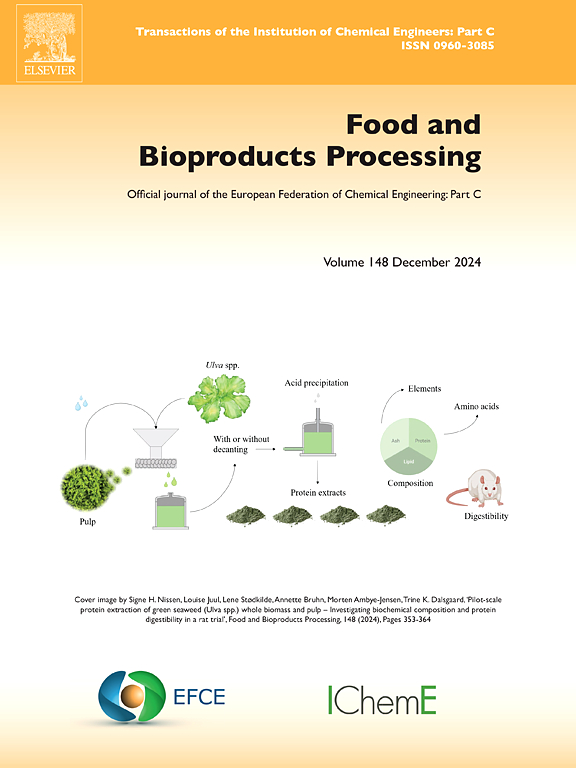Development of tryptophan-modified chitosan-based nanorelease system: Universal encapsulation and targeted delivery of hydrophilic and hydrophobic bioactive compounds
IF 3.4
2区 农林科学
Q2 BIOTECHNOLOGY & APPLIED MICROBIOLOGY
引用次数: 0
Abstract
This study successfully constructed an amphiphilic universal nanodelivery system (Trp-CS-PC) by modifying chitosan (CS) with hydrophobic L-Trp and dynamically self-assembling it with pectin (PC). This system achieved efficient and universal encapsulation of hydrophilic bovine collagen peptides (BCP) and hydrophobic curcumin (CUR) (encapsulation efficiency: BCP, 92.2 ± 3.1 %; CUR, 73.4 ± 4.5 %). Mechanistic studies indicate that the hydrophilic backbone in Trp-CS-PC fixes BCP through hydrogen bonding networks, while the hydrophobic microdomain stabilizes CUR through π-π stacking interactions. Trp-CS and PC formed a core-shell structure via pH-responsive ionic crosslinking, which maintained a tight network in the gastric environment, significantly reducing the release rates of BCP and CUR in gastric fluid (BCP: 18.23 ± 1.05 %; CUR: 36.56 ± 2.17 %). Trp modification significantly improved the solubility (5.95 ± 0.38 mg/mL) and mucosal adhesion of CS, making this delivery system possess excellent storage stability (size variation <5 % within 28 days) and intestinal retention ability (cumulative release of BCP and CUR <59 % after gastrointestinal digestion). Furthermore, in vitro activity evaluation results showed that the biological activity retention of BCP and CUR delivered by Trp-CS-PC was significantly higher than that of the control group (P < 0.05). This study provides new ideas and strategies for the research and application of universal oral delivery systems for hydrophilic and hydrophobic bioactive substances.
基于色氨酸修饰壳聚糖的纳米释放系统的开发:亲水和疏水生物活性化合物的通用封装和靶向递送
本研究利用疏水性l -色氨酸修饰壳聚糖(CS),并与果胶(PC)动态自组装,成功构建了两亲性通用纳米递送体系(Trp-CS-PC)。该系统实现了亲水性牛胶原蛋白肽(BCP)和疏水性姜黄素(CUR)的高效通用包封(包封率:BCP, 92.2 ± 3.1 %; CUR, 73.4±4.5 %)。机理研究表明,色氨酸- cs - pc中的亲水骨架通过氢键网络固定BCP,而疏水微结构域通过π-π堆叠相互作用稳定CUR。Trp-CS和PC通过ph响应离子交联形成核壳结构,在胃环境中保持紧密的网络,显著降低BCP和CUR在胃液中的释放率(BCP: 18.23 ± 1.05 %;坏蛋:36.56 ±2.17 %)。色氨酸修饰显著提高了CS的溶解度(5.95 ± 0.38 mg/mL)和粘膜粘附性,使该给药体系具有良好的储存稳定性(28天内大小变化<;5 %)和肠道保留能力(胃肠道消化后BCP和CUR的累积释放<;59 %)。体外活性评价结果显示,Trp-CS-PC递送的BCP和CUR的生物活性保留率显著高于对照组(P <; 0.05)。本研究为亲疏水生物活性物质通用口服给药系统的研究和应用提供了新的思路和策略。
本文章由计算机程序翻译,如有差异,请以英文原文为准。
求助全文
约1分钟内获得全文
求助全文
来源期刊

Food and Bioproducts Processing
工程技术-工程:化工
CiteScore
9.70
自引率
4.30%
发文量
115
审稿时长
24 days
期刊介绍:
Official Journal of the European Federation of Chemical Engineering:
Part C
FBP aims to be the principal international journal for publication of high quality, original papers in the branches of engineering and science dedicated to the safe processing of biological products. It is the only journal to exploit the synergy between biotechnology, bioprocessing and food engineering.
Papers showing how research results can be used in engineering design, and accounts of experimental or theoretical research work bringing new perspectives to established principles, highlighting unsolved problems or indicating directions for future research, are particularly welcome. Contributions that deal with new developments in equipment or processes and that can be given quantitative expression are encouraged. The journal is especially interested in papers that extend the boundaries of food and bioproducts processing.
The journal has a strong emphasis on the interface between engineering and food or bioproducts. Papers that are not likely to be published are those:
• Primarily concerned with food formulation
• That use experimental design techniques to obtain response surfaces but gain little insight from them
• That are empirical and ignore established mechanistic models, e.g., empirical drying curves
• That are primarily concerned about sensory evaluation and colour
• Concern the extraction, encapsulation and/or antioxidant activity of a specific biological material without providing insight that could be applied to a similar but different material,
• Containing only chemical analyses of biological materials.
 求助内容:
求助内容: 应助结果提醒方式:
应助结果提醒方式:


